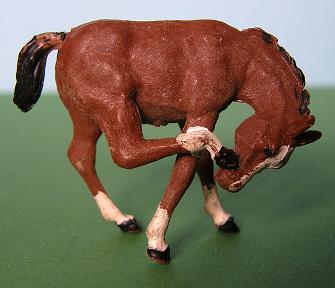Britains and Herald Plastic Farm
Collecting, Restoration
Disclaimer
Any information contained on this page is followed at the readers own risk. It is up to the reader to decide whether or not the information is applicable on a per model basis. It is advisable to practice restoration on cheap/common/disposable models first and not to carry out restoration if in any doubt.
Repair
 Thank you to Justin for prompting this entry. He asked about gluing broken models.
Thank you to Justin for prompting this entry. He asked about gluing broken models.
I use Loctite® All Plastics. It
is very strong, even with polythene, which is usually difficult to glue. You only need a tiny amount, so it is possible to repair
without leaving unsightly glue marks. I find it best to squeeze the tube at an angle a little above the horizontal to help control
how much is used. The progress of the glue up the transparent nozzle can be seen so the appropriate amount can be dispensed.
The photo to the right shows the repaired leg of a scratching foal.
This glue is not suitable for children. Read all the packaging notes and instructions before use.
Cleaning
 Most models are not suited to cleaning as play worn ones look odd when clean and mint figures are usually clean already. However,
occasionally a model turns up that is in lovely condition except a bit dirty.
Most models are not suited to cleaning as play worn ones look odd when clean and mint figures are usually clean already. However,
occasionally a model turns up that is in lovely condition except a bit dirty.
When cleaning a model, there is always a chance some paint will be lost. However, this is normally loose paint that would
come off sooner or later anyway.
To clean a model, I simply use a bit of water and washing-up liquid. For large, unpainted areas I use a cotton bud to work in the
washing-up liquid and for painted areas I use a tiny, soft (sable or simulated) paintbrush. When cleaning painted areas, always brush from
the painted area towards the bare plastic. If you work the other way, the brush hairs can find their way under the paint and dislodge it.
Repainting
I have never repainted a model as I feel, like most collectors, it is better they are in a poor, original condition than restored. If you do repaint a figure, it helps to put a mark underneath to make it obvious, in case it gets passed on at a later date.